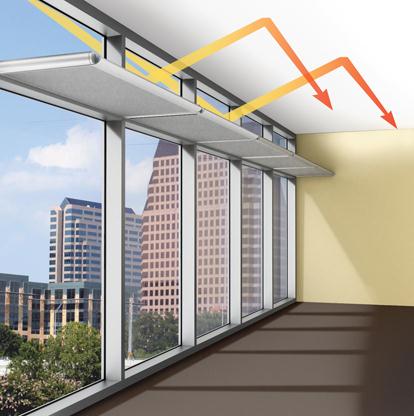Light shelf
A light shelf is a passive architectural device used to reflect natural daylight into a building. 'Bouncing' sunlight off a horizontal surface distributes it more evenly and deeply within a space, whereas direct sunlight can cause glare near an opening, whilst leaving dark areas further in.
Light shelves can be fixed either externally, internally or both (which often works best in providing an even illumination gradient). They are often designed as part of a broader daylight and shading strategy.
They are generally found on walls facing the sun, as on 'pole-facing walls' would tend to act only as sunshades. On east and west orientations, they may act as an effective means of reducing direct heat gain and glare but will not bounce light as deeply into the space.
Exterior light shelves can be more effective than internal light shelves as they do not radiate as much heat into the space and so can help reduce solar heat gain and cooling loads.
Internal light shelves however may be easier to maintain as they can be more accessible and less exposed. In very broad terms, internal light shelves tend to have a depth similar to the height of the opening that they sit below.
Light shelves are commonly made from; timber, glass, plastics, metal panels, plaster, acoustic panels and so on. The choice of material may be determined by considerations regarding the design of the rest of the building, structural strength, ease of maintenance, cost, durability and so on. Opacity is not essential, as some transparency can help more-evenly distribute light.
To be able to reflect light up to the ceiling, the upper surface of light shelves should be matte white or diffusely specular, it does not need to be shiny or reflective. Ideally, the ceiling should also be a light colour.
Light shelves can:
- Enhance daylight quality.
- Reduce the need for artificial lighting and so reduce energy consumption.
- Reduce cooling loads.
- Increase occupant comfort and productivity.
- Enhance design aesthetics.
Some of the limitations or drawbacks of light shelves are as follows:
- They tend to be best-suited to mild rather than tropical or desert climates.
- They can interfere with the installation of sprinkler systems.
- They may require a higher floor-to-ceiling height.
- Their design must be coordinated with windows.
- They Increase maintenance requirements.
Alternative solutions to light shelves include the use of blinds and louvre window systems!
[edit] Related articles on Designing Buildings Wiki
Featured articles and news
Latest Build UK Building Safety Regime explainer published
Key elements in one short, now updated document.
UKGBC launch the UK Climate Resilience Roadmap
First guidance of its kind on direct climate impacts for the built environment and how it can adapt.
CLC Health, Safety and Wellbeing Strategy 2025
Launched by the Minister for Industry to look at fatalities on site, improving mental health and other issues.
One of the most impressive Victorian architects. Book review.
Common Assessment Standard now with building safety
New CAS update now includes mandatory building safety questions.
RTPI leader to become new CIOB Chief Executive Officer
Dr Victoria Hills MRTPI, FICE to take over after Caroline Gumble’s departure.
Social and affordable housing, a long term plan for delivery
The “Delivering a Decade of Renewal for Social and Affordable Housing” strategy sets out future path.
A change to adoptive architecture
Effects of global weather warming on architectural detailing, material choice and human interaction.
The proposed publicly owned and backed subsidiary of Homes England, to facilitate new homes.
How big is the problem and what can we do to mitigate the effects?
Overheating guidance and tools for building designers
A number of cool guides to help with the heat.
The UK's Modern Industrial Strategy: A 10 year plan
Previous consultation criticism, current key elements and general support with some persisting reservations.
Building Safety Regulator reforms
New roles, new staff and a new fast track service pave the way for a single construction regulator.
Architectural Technologist CPDs and Communications
CIAT CPD… and how you can do it!
Cooling centres and cool spaces
Managing extreme heat in cities by directing the public to places for heat stress relief and water sources.
Winter gardens: A brief history and warm variations
Extending the season with glass in different forms and terms.
Restoring Great Yarmouth's Winter Gardens
Transforming one of the least sustainable constructions imaginable.























